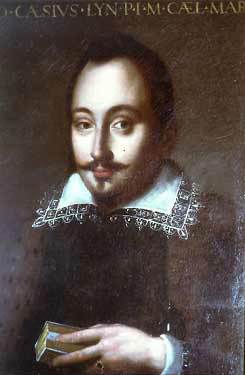- Federico Cesi
Infobox_Scientist
name = Federico Angelo Cesi |150px
|150px
caption = Federico Angelo Cesi
birth_date = February 26, 1585
birth_place = Rome, Italy
death_date = August 1, 1630
death_place = Acquasparta, Italy
residence =
nationality = Italy
field =naturalist ,botany ,natural history , andnatural philosophy
alma_mater = privately educated
known_for = founding theAccademia dei Lincei
footnotes =Federico Angelo Cesi (
February 26 ,1585 Rome -August 1 ,1630 Acquasparta ) was an Italianscientist ,naturalist , and founder of theAccademia dei Lincei . On his father's death in 1630, he became briefly lord of Acquasparta.Biography
Federico Cesi was born to an aristocratic family highly connected in Rome and the
Papal States . The family derives its name fromCesi , a little town near Rome. They had a close connection with theCatholic Church , Frederico's uncle Bartolomeo Cesi was a cardinal in the church, and most of their wealth came from that connection [ [http://galileo.rice.edu/gal/lincei.html galileo.rice.edu Federico Cesi (1585-1630) and the Accademia dei Lincei, by Luigi Belloni] ] . Federico was the first of eleven legitimate male children and was born in Palazzo Cesi, in via della Maschera d'Oro, Rome, February 26, 1585. His father was Federico, marchese di Monticelli (1562 - 1630) [Federico, marchese di Monticelli, son of Angelo, first duca di Acquasparta (1588), and first principe di San Polo and Sant'Angelo (1613), married Olimpia Orsini di Mentana, 12 March 1616 (Gottardo Garollo, "Dizionario biografico universale", "s.v." "Cesi"); she commissioned the chapel of Saint Francesco in theChurch of the Gesù .] and his mother was Olimpia Orsini ofTodi . In 1614 Cesi was married to Artemisia Colonna, the daughter of Francesco, principe di Palestrina; she died two years later. In 1616 he was married to Salviati Isabella, the daughter of the Marquis of Lorenzo. In 1618 he moved toAcquasparta and lived there until his death at the age of forty-five.The "Accademia dei Lincei" ("Academy of the Lynxes")
In 1603, at the age of eighteen, Cesi invited three slightly older friends, the Dutch physician
Johannes Van Heeck (in Italy Giovanni Ecchio), and two fellow Umbrians, mathematicianFrancesco Stelluti of Fabriano and polymathAnastasio de Filiis of Terni to join with him in the founding of the "Accademia dei Lincei" ("Academy of the Lynxes"), aimed at the understanding of allnatural sciences through a method of research based upon observation, experiment, and the inductive method. Their goal was to penetrate the secrets of nature, observing it at both microscopic and macroscopic levels. The four men chose the name "Lincei" (lynx ) fromGiambattista della Porta 's book "Magia Naturalis", which had an illustration of the fabled cat on the cover and the words "..."with lynx like eyes, examining those things which manifest themselves, so that having observed them, he may zealously use them" [ [http://homepages.tscnet.com/omard1/jportat3a.html "Della Porta's Life - From Giambattista Della Porta Dramatist" by Louise George Clubb - Princeton University Press Princeton, New Jersey, 1965] ] . Cesi chose the sharp eyed lynx and theeagle for the Academy's symbols. The academy's motto, chosen by Cesi, was: "take care of small things if you want to obtain the greatest results" ("minima cura si maxima vis").Since it was an uncertain time to conduct scientific research — in 1578 the
Inquisition had closed Giambattista della Porta's "Academia Secretorum Naturae " in Naples under suspicion ofsorcery [ [http://faculty.ed.umuc.edu/~jmatthew/naples/dellaporta.htm faculty.ed.umuc.edu, "Giambattista della Porta (1535-1615)", 2006 Jeff Matthews] ] — the "Accademia dei Lincei" had rough beginnings. Cesi's own father forbade Cesi's association with the other three men, suspecting them of undermining his authority and trying to separate his son from family interests [ [http://homepages.tscnet.com/omard1/jportat3a.html "Della Porta's Life - From Giambattista Della Porta Dramatist" by Louise George Clubb - Princeton University Press Princeton, New Jersey, 1965] ] . The four "Lynxes" soon returned to their native cities and continued to communicate only by letter, adopting astronomical pen names: Cesi, perpetual president, was "Celívago" ["Dizionario biografico universale"] Cesi traveled toNaples where he met della Porta, who he seemed to have been corresponding with for some time. There he described his academy to Della Porta, who encouraged Cesi to continue with his endeavors [ [http://homepages.tscnet.com/omard1/jportat3a.html "Della Porta's Life - From Giambattista Della Porta Dramatist" by Louise George Clubb - Princeton University Press Princeton, New Jersey, 1965] ] . The academy managed to survive due to Cesi resources as a rich nobleman and his diplomatic skills in navigating the politics ofCounter-Reformation Rome. Cesi managed to expand the ranks of the academy, recruiting Giambattista della Porta himself in 1610 andGalileo Galilei in 1611. Cesi's Academy published Galileo's "Istoria e dimostrazione intorno alle macchie solari " (Letters on Sunspots) in 1613, "The Assayer " in 1623, and also had a hand in defending Galileo in his controversies with establishment leaders and ecclesiastical authorities.Cesi's own intense activity in the Academy was cut short by his sudden death in 1630 and the original Accademia dei Lincei did not survive his death. It was revived in its currently well known form in 1847 by
Pope Pius IX .Other contributions
* Had a hand in coining the name "
telescope " for Galileo's new invention.
* Directed excavations ofCarsulae .Books by Federico Cesi
* "Theatrum totius naturae", a "universal theatre of nature", which he began around 1615 and never completed; it was a project for a comprehensive encyclopedia of natural history.
Notes
References
* [http://it.wikipedia.org/wiki/Federico_Cesi Federico Cesi - Italian Wikipedia]
* [http://64.233.179.104/translate_c?hl=en&u=http://www.lincei-celebrazioni.it/icesi.html&prev=/search%3Fq%3DFederico%2BCesi%26hl%3Den%26safe%3Doff%26sa%3DG COMMITTEE FOR THE NATIONAL IV CENTENNIAL OF THE FOUNDATION ACADEMY OF LINCEI - Federico Cesi]
* [http://findarticles.com/p/articles/mi_m1134/is_n4_v107/ai_20549274 "The sharp-eyed lynx, outfoxed by nature: Galileo and friends taught us that there is more to observing than meets the eye - Column", Natural History, May, 1998 by Stephen Jay Gould]
* [http://galileo.rice.edu/gal/lincei.html galileo.rice.edu Federico Cesi (1585-1630) and the Accademia dei Lincei, by Luigi Belloni]Persondata
NAME=Cesi,Federico
ALTERNATIVE NAMES=
SHORT DESCRIPTION=Aristocrat, scientist
DATE OF BIRTH=1585-02-26
PLACE OF BIRTH=Rome
DATE OF DEATH=1630-08-01
PLACE OF DEATH=Acquasparta, Italy
Wikimedia Foundation. 2010.
